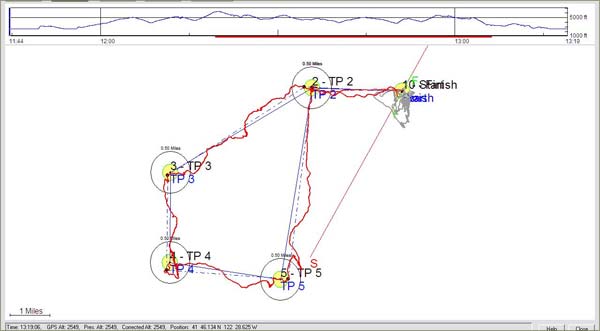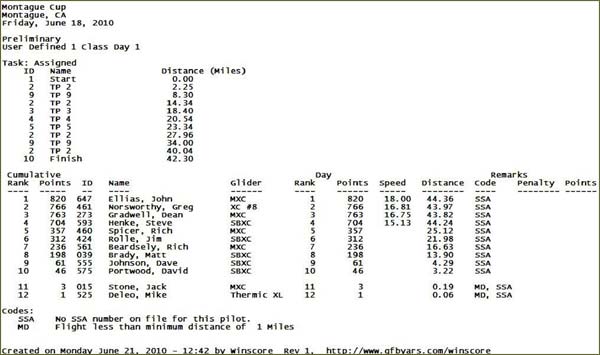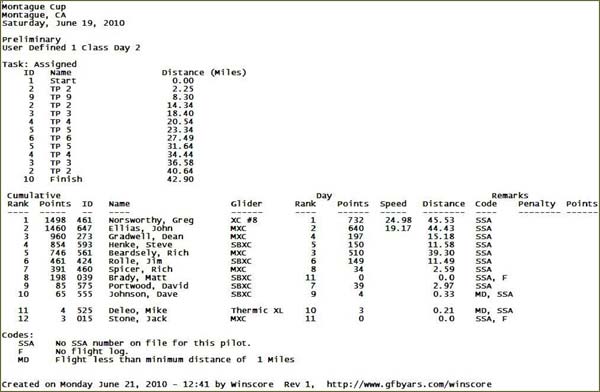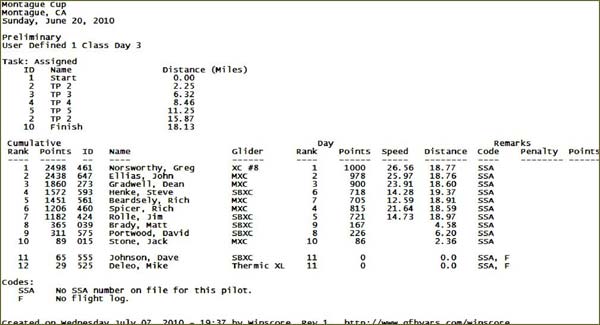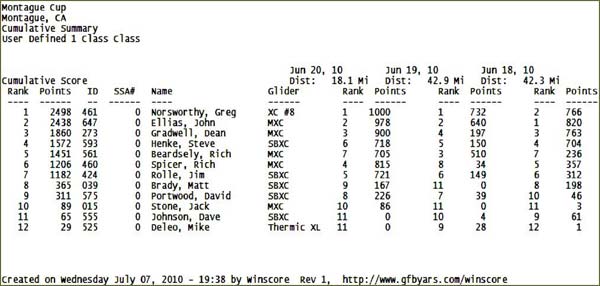| Contests | |||||||
| Home | XC Pins | XC Gear | XC Tech | Links |

| Contests | Organize a Contest | Contests Gallery | ||
2010 Montague Cross Country Cup
June 18th to 20th
| Official Results | Notes & GPS Scoring | Teams | Photos: 1 2 3 4 |
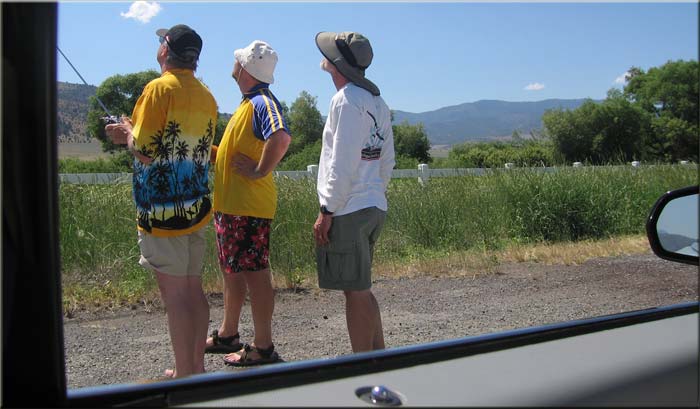
| Dean Gradwell's Notes | |||||||||||||||||||||||||||||||||||||||
A few notes from Dean Gradwell on the Montague Cross
Country event.
|
|||||||||||||||||||||||||||||||||||||||
| GPS Scoring at Montague — By John Ellias | |||||||||||||||||||||||||||||||||||||||
|
This year at the Montague XC contest, a new scoring system was tested which has the potential to improve the accuracy of our contest scoring. This system is exactly the same as the ones used in full-size soaring contests. The contest was officially scored manually, just as it always has been, but at the same time, a new scoring system was tested using a small GPS logger in each glider. RC cross country soaring has always relied on each team to provide their own time and distance estimates for scoring the contests. While this has generally worked adequately, there have always been inherent errors using this system. Start and finish times are not easy to determine when the glider is at 4,000’ agl or higher. Rounding turnpoints can be very difficult and there have been instances where competing teams have felt other teams missed turnpoints. When landing out, we have relied on teams to measure back to the nearest turnpoint using their vehicle’s odometer. All these procedures introduce many opportunities for errors. Using GPS, we now have a way to very accurately record each flight and score the entire contest with pinpoint accuracy. The heart of the system is the small onboard “Skytrace” GPS receiver which logs position and altitude data once per second. After the flight, the GPS data are downloaded and analyzed by the full-size scoring software “Winscore” developed by Guy Byars. We first tested the GPS system at the Davis contest in May of this year. We found the system generally worked, but there were a few problems and bugs that arose, mostly because we were using a program that was written for full-size soaring, not RC soaring. Bob Nelson and I systematically worked our way through each of the problems until we were confident that we could actually score the upcoming Montague contest with the new system. Winscore software uses the 2010 Regional FAI Class Rules for full-size soaring as published on the Soaring Society of America’s website. The scoring computations differ somewhat from the FAI scoring that we have used when manually scoring the contest. One difference is Winscore de-values a particular day based on the number of contestants that fail to complete the task. The greater the number of non-finishers the more the day is de-valued. On a de-valued day the winner will get something less than 1000 points. Another difference in the scoring is in the definition of “making a turnpoint”. The picture below is a screen shot of a portion of flight as shown by Winscore.
It shows that based on the “old” rules, this turnpoint is actually not properly achieved. The glider flew beyond the turnpoint but did not round the turnpoint as the rules call for. However, with Winscore a turnpoint is considered achieved as long as the glider penetrates a .2 mile radius cylinder around the turnpoint. So in the case shown below Winscore considers this an achieved turnpoint. There are many nice features in the Winscore program. Each contestant’s flight can be plotted as shown below. Distances can be measured with ease and great accuracy.
The results of the Montague Cup XC event as scored by Winscore are shown below:
A quick review of the scores as scored by Winscore vs. manual scoring shows very close correlation:
Notice that the Winscore scores are less than the manual scoring. This is because two of the days were de-valued by Winscore since there were many non-finishers on those days. The other discrepancy was with team 015. The reason for the difference between the manual and Winscore scores was that on the Sunday flight, Winscore determined the first turnpoint was never properly achieved by team 015, and therefore the flight was considered to have ended at the first turnpoint. Based on our experience at Montague we are ready to score the next contest officially with gps using Winscore. |
| Official Results | Notes & GPS Scoring | Teams | Photos: 1 2 3 4 |
| Home | Contests | Organize a Contest | Contests Galley | XC Pins | XC Gear | XC Tech | Links | |



